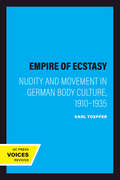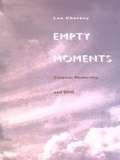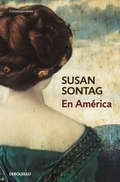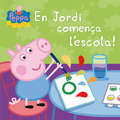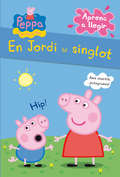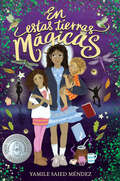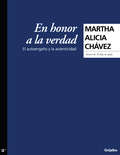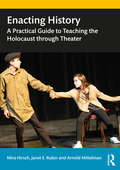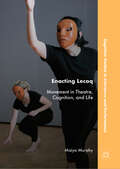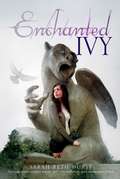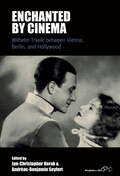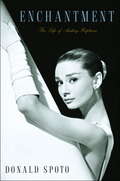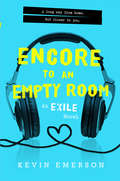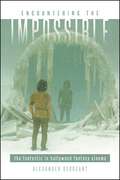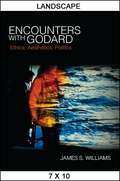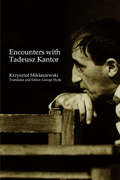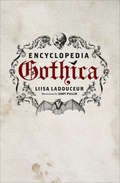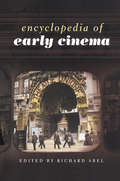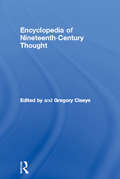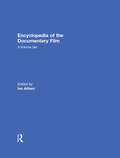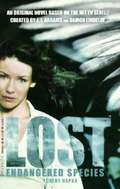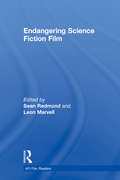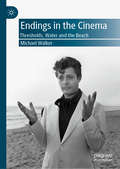- Table View
- List View
Empire of Ecstasy: Nudity and Movement in German Body Culture, 1910–1935 (Weimar and Now: German Cultural Criticism #13)
by Karl ToepferEmpire of Ecstasy offers a novel interpretation of the explosion of German body culture between the two wars—nudism and nude dancing, gymnastics and dance training, dance photography and criticism, and diverse genres of performance from solo dancing to mass movement choirs. Karl Toepfer presents this dynamic subject as a vital and historically unique construction of "modern identity." The modern body, radiating freedom and power, appeared to Weimar artists and intelligentsia to be the source of a transgressive energy, as well as the sign and manifestation of powerful, mysterious "inner" conditions. Toepfer shows how this view of the modern body sought to extend the aesthetic experience beyond the boundaries imposed by rationalized life and to transcend these limits in search of ecstasy. With the help of much unpublished or long-forgotten archival material (including many little-known photographs), he investigates the process of constructing an "empire" of appropriative impulses toward ecstasy. Toepfer presents the work of such well-known figures as Rudolf Laban, Mary Wigman, and Oskar Schlemmer, along with less-known but equally fascinating body culture practitioners. His book is certain to become required reading for historians of dance, body culture, and modernism.
Empty Moments: Cinema, Modernity, and Drift
by Leo CharneyIn Empty Moments, Leo Charney describes the defining quality of modernity as "drift"--the experience of being unable to locate a stable sense of the present. Through an exploration of artistic, philosophical, and scientific interrogations of the experience of time, Charney presents cinema as the emblem of modern culture's preoccupation with the reproduction of the present. Empty Moments creates a catalytic dialogue among those who, at the time of the invention of film, attempted to define the experience of the fleeting present. Interspersing philosophical discussions with stylistically innovative prose, Charney mingles Proust's conception of time/memory with Cubism's attempt to interpret time through perspective and Surrealism's exploration of subliminal representations of the present. Other topics include Husserl's insistence that the present can only be fantasy or fabrication and the focus on impossibility, imperfection, and loss in Kelvin's laws of thermodynamics. Ultimately, Charney's work hints at parallels among such examples, the advent and popularity of cinema, and early film theory. A book with a structural modernity of its own, Empty Moments will appeal to those interested in cinema and its history, as well as to other historians, philosophers, literary, and cultural scholars of modernity.
En América
by Susan SontagMaryna Zalezowska, la más célebre de las actrices polacas, decide partir hacia América junto con su marido, su hijo, un joven escritor que la idolatra y varios amigos más, impulsados por la idea de construir una comunidad utópica. Pero allí descubrirán que la felicidad americana se construye de un modo distinto al esperado. Susan Sontag ha escrito esta atrevida novela por medio de unos personajes tan singulares -un conde, un escritor enamorado, una actriz famosa- como sus propios destinos. A través de sus ojos y de sus pasiones el lector se embarca en un intenso viaje desde el corazón de Europa hasta la tierra casi virgen de California. «La prosa de Sontag es ágil, lúdica... Como siempre, aparecen ideas estimulantes en cada rincón.» THE NEW YORK TIMES BOOK REVIEW "Una novela valiente y hermosa." THE WASHINGTON POST
En Jordi comença l'escola! (La Porqueta Pepa. Primeres lectures)
by Varios AutoresAprenem a llegir amb les aventures de la Pepa, la porqueta més famosa. Llegeix aquesta història i descobriràs què li va passar a la Pepa el primer dia que en Jordi va anar a escola amb ella. Avui és el primer dia que en Jordi va a l'escola, i a la Pepa no li fa gaire gràcia. Però quan vegi com es diverteixen els altres nens amb el seu germanet, potser canviarà d'idea... Els llibres de la col·lecció «Primeres lectures» de la Porqueta Pepa estan pensats per nens que tot just comencen a llegir. Els textos contenen vocabulari senzill, els interior són molt visuals i, a més a més, conten les divertides aventures del personatge més estimat pels nens. Tot això garanteix que els petits lectors se sentin motivats per la lectura, s'entretinguin i s'estimuli la seva imaginació.
En Jordi té singlot (La Porqueta Pepa)
by Varios AutoresLa Pepa i en Jordi tenen tantes ganes de sortir a jugar al jardí que esmorzen massa de pressa i a en Jordi li agafa singlot. Descobreix el remei de la Pepa per fer-l'hi passar.
En estas tierras mágicas
by Yamile Saied MéndezMinerva esta encargada de sus hermanas después de la desaparición de su madre en estamágica historia argentina de medio grado que combina perfectamente con la historia de Peter Pan. Minerva must take care of her sisters after her mother's disappearance in this magical Argentinean middle grade story that pairs perfectly with Peter Pan.Ya a los doce años, Minerva Soledad Miranda está decidida a alcanzar sus metas, a pesar de asumir más responsibilidades que los demás niños de las escuela--como cuidar a sus dos hermanas mientras su mamá maneja dos trabajos. Pero una noche, la mamá de Minerva no regresa a casa y Minerva tiene que decider qué hacer. ¿Fue Mama secuestrada por ICE? ¿Serán las niñas enviadas a hogares de acogida o centros de detención para niños inmigrantes? Minerva y su hermanas no pueden dejar que nadie sepa que mamá ha desparecido. Simplemente fingirán que todo sigue normal hasta que ella regrese. El plan de Minerva se desmorona la primera tarde, cuando su hermanita hace un berrinche durante la audición de Minerva para la obra de Peter Pan. Pero a medida que pasan los días y Minerva se preocupa cada vez más por su madre, algo mágico parece estar cuidándolos: dejándoles pastelitos, ayudándolos a encontrar dinero, e incluso dirigiéndolos a amigos y familiares lejanos que pueden ayudarlos. Eventualmente, Minerva debe tomar la decision más dificil de su vida. Y cuando lo haga, estará preparada para enfrentar los desafíos de la vida, con amistad, esparanza y un poco de magia de hadas. Twelve-year-old Minerva Soledad Miranda is determined to reach her goals, despite shouldering more responsibility than the other kids at school--like caring for her two sisters while her mom works two jobs. But one night, Minerva's mom doesn't come home, and Minerva has to figure out what to do. Was Mamá snapped up by ICE? Will the girls be sent to foster homes or holding centers for migrant kids? Minerva and her sisters can't let anyone know Mamá has disappeared. They'll just pretend everything is normal until she comes back. Minerva's plan falls apart the first afternoon, when her baby sister throws a tantrum during Minerva's audition for Peter Pan. But as the days pass and Minerva grows ever more worried about her mother, something magical seems to be watching out for them: leaving them cupcakes, helping her find money, even steering them to friends and distant family who can help. Eventually, Minerva must make the hardest choice of her life. And when she does, she'll be prepared to face life's challenges--with friendship, hope, and a little bit of fairy magic.
En honor a la verdad
by Martha Alicia Chávez"No es motivo de culpabilidad, vergüenza ni desprecio reconocer que de muchas formas todos nos autoengañamos. Sin embargo, sí es necesario hacernos conscientes de esta situación para poder aceptar la verdad, que nos permite vivir en paz. En honor a la verdad es un libro sobre autenticidad, congruencia, confianza y el poder sanador de la verdad. En sus páginas, la autora nos muestra abiertamente las muchas formas en que nos autoengañamos respecto a temas como los hijos, la relación de pareja, el dinero y otros asuntos sociales, y nos brinda el mejor método para reconocer la verdad como parte fundamental de nuestro proceso de maduración, en todos los aspectos de la vida, así como para evitar que el autoengaño aparezca incluso detrás de nuestras más loables intenciones."
Enacting History: A Practical Guide to Teaching the Holocaust through Theater
by Janet E. Rubin Mira Hirsch Arnold MittelmanEnacting History is a practical guide for educators that provides methodologies and resources for teaching the Holocaust through a variety of theatrical means, including scripted texts, verbatim testimony, devised theater techniques and process-oriented creative exercises. A close collaboration with the USC Shoah Foundation I Witness program and the National Jewish Theater Foundation Holocaust Theater International Initiative at the University of Miami Miller Center for Contemporary Judaic Studies resulted in the ground-breaking work within this volume. The material facilitates teaching the Holocaust in a way that directly connects students to individual people and historical events through the art of theater. Each section is designed to help middle and high school educators meet curricular goals, objectives and standards and to integrate other educational disciplines based upon best practices. Students will gain both intellectual and emotional understanding by speaking the words of survivors, as well as young characters in scripted scenes, and developing their own performances based on historical primary sources. This book is an innovative and invaluable resource for teachers and students of the Holocaust; it is an exemplary account of how the power of theater can be harnessed within the classroom setting to encourage a deeper understanding of this defining event in history.
Enacting Lecoq: Movement In Theatre, Cognition, And Life (Cognitive Studies In Literature And Performance Ser.)
by Maiya MurphyThis book examines the theatrical movement-based pedagogy of Jacques Lecoq (1921-1999) through the lens of the cognitive scientific paradigm of enaction. The conversation between these two both uncovers more of the possible cognitive processes at work in Lecoq pedagogy and proposes how Lecoq’s own practical and philosophical approach could have something to offer the development of the enactive paradigm. Understanding Lecoq pedagogy through enaction can shed new light on the ways that movement, key to Lecoq’s own articulation of his pedagogy, might cognitively constitute the development of Lecoq’s ultimate creative figure – the actor-creator. Through an enactive lens, the actor-creator can be understood as not only a creative figure, but also the manifestation of a fundamentally new mode of cognitive selfhood. This book engages with Lecoq pedagogy’s significant practices and principles including the relationship between the instructor and student, identifications, mime, play, mask work, language, improvisation, and movement analysis.
Enchanted Ivy
by Sarah Beth DurstSixteen-year-old Lily is determined to attend Princeton University, so she's thrilled when she meets a group of powerful alumni, the Old Boys, who guarantee her admission if she passes a secret test and finds the Princeton Key. In her search to seal her future, Lily learns of a magical, alternate Princeton and discovers that the Princeton Key, which opens the door between the two worlds, is not an object, but a person. And it's her. Now Lily is caught in a power struggle between the Old Boys and the leaders of the magical realm, and unless she can find a way to make peace between the two sides, Lily's mother--and possibly Lily herself--will die. and dragons might be out for blood, Lily will need all of her ingenuity and courage--and a little magic--to unite the worlds and unlock the secrets of her past and her future.
Enchanted by Cinema: Wilhelm Thiele between Vienna, Berlin, and Hollywood (Film Europa #29)
by Jan-Christopher Horak and Andréas-Benjamin SeyfertWilliam Thiele is remembered today as the father of the sound film operetta with seminal classics such as Drei von der Tankstelle (1930). While often considered among the most accomplished directors of Late Weimar cinema, as an Austrian Jew he was vilified during the onset of the Nazi regime in 1933 and fled to the United States where he continued making films until the end of his career in 1960. Enchanted by Cinema closely examines the European musical film pioneer’s work and his cross-cultural perspective across forty years of filmography in Berlin and Hollywood to account for his popularity while discussing issues of ethnicity, exile, comedy, music, gender, and race.
Enchantment
by Donald SpotoHer name is synonymous with elegance, style and grace. Over the course of her extraordinary life and career, Audrey Hepburn captured hearts around the world and created a public image that stands as one of the most recognizable and beloved in recent memory. But despite her international fame and her tireless efforts on behalf of UNICEF, Audrey was also known for her intense privacy. With unprecedented access to studio archives, friends and colleagues who knew and loved Audrey, bestselling author Donald Spoto provides an intimate and moving account of this beautiful, elusive and talented woman.Tracing her astonishing rise to stardom, from her harrowing childhood in Nazi-controlled Holland during World War II to her years as a struggling ballet dancer in London and her Tony Award-winning Broadway debut in Gigi, Spoto illuminates the origins of Audrey's tenacious spirit and fiercely passionate nature.She would go on to star in some of the most popular movies of the twentieth century, including Roman Holiday, Sabrina, Funny Face, The Nun's Story, Breakfast at Tiffany's and My Fair Lady. A friend and inspiration to renowned designer Hubert de Givenchy, Audrey emerged as a fashion icon as well as a film legend, her influence on women's fashion virtually unparalleled to this day.But behind the glamorous public persona, Audrey Hepburn was both a different and a deeper person and a woman who craved love and affection. Donald Spoto offers remarkable insights into her professional and personal relationships with her two husbands, and with celebrities such as Gregory Peck, William Holden, Fred Astaire, Gary Cooper, Robert Anderson, Cary Grant, Peter O'Toole, Albert Finney and Ben Gazzara. The turbulent romances of her youth, her profound sympathy for the plight of hungry children, and the thrills and terrors of motherhood prepared Audrey for the final chapter in her life, as she devoted herself entirely to the charity efforts of an organization that had once come to her rescue at the end of the war: UNICEF.Donald Spoto has written a poignant, funny and deeply moving biography of an unforgettable woman. At last, Enchantment reveals the private Audrey Hepburn--and invites readers to fall in love with her all over again."She was as funny as she was beautiful. She was a magical combination of high chic and high spirits." --Gregory Peck"In spite of her fragile appearance, she's like steel." --Cary Grant"Audrey was known for something which has disappeared, and that is elegance, grace and manners . . . God kissed her on the cheek, and there she was." --Billy Wilder"There is not a woman alive who does not dream of looking like Audrey Hepburn." --Hubert de Givenchy"Her magnetism was so extraordinary that everyone wanted to be close to her. It was as if she placed a glass barrier between herself and the world. You couldn't get behind it easily. It made her remarkably attractive." --Stanley Donen"She has authentic charm. Most people simply have nice manners." --Alfred LuntFrom the Hardcover edition.
Enchantment: The Life of Audrey Hepburn
by Donald SpotoMore than a decade after her death in 1993, Audrey Hepburn remains an incomparable icon of movie style, of high fashion and mid-twentieth-century elegance. Born in Brussels in 1929, Audrey was the daughter of a British father and a Dutch Baroness. But when she was five, her father deserted the family, and it was not until she was 30 that Audrey found him again. With the outbreak of war in 1939, her mother thought they would be safer in Holland than Holland Park, but, although they survived the German Occupation, the experience left its physical and emotional scars. Back in England again, Audrey studied ballet with Marie Rambert. After a few West End musicals and a few minor film parts, she was spotted by the colourful and eccentric author, Colette, to star in a stage version of her novel, Gigi. And then Audrey's career took off. Her debut screen role was the Princess in William Wyler's enchanting Roman Holiday. It won her an Oscar. Audrey often described herself as an actress who didn't have much technique because she never learned to act. But she had that rare, instinctive ability to reach out to an audience. Billy Wilder, who directed her in Sabrina said, 'She was just born with this kind of quality and she made it look so unforced, so simple, so easy. . . You cannot learn it. God kissed her on the cheek and there she was. 'She brought a unique grace and high spirits to a number of highly acclaimed films - from Funny Face and The Nun's Story to My Fair Lady, Breakfast at Tiffany's, Charade, Wait Until Dark and Robin and Marian. For a while it looked as though her personal life would follow the Hollywood dream. But her marriage to Mel Ferrer, with whom she starred in War and Peace, was not to last. There were passionate but short-lived affairs, some revealed for the first time in this book. She married and divorced a second time. But she pretty much retired from movie-making, and dedicated the last years of her life, as Special Ambassador for UNICEF, to touring Africa and South America to help hungry children. With all the insight, background knowledge and innate sympathy for his subject, qualities that have made his biographies of Hitchcock, Dietrich, Monroe and Bergman such international successes, Donald Spoto truly captures the spirit of an elusive, beautiful, talented and vulnerable woman.
Encore
by Joan Lowery NixonCassie's daughter Erin, who identifies closely with her grandmother Abby, wants to be an actress more than anything in the world, but is disappointed that her parents do not approve of her working in the television medium.
Encore to an Empty Room
by Kevin EmersonKevin Emerson's Exile trilogy combines the swoon-worthy romance of a Susane Colasanti novel with the rock 'n' roll of Eleanor & Park.<P><P> Filled with infectious music, mystery, and romance, the electrifying Encore to an Empty Room, the second book in the Exile series, doesn't miss a beat.Summer always wanted Dangerheart--the band of talented exiles she manages--to find success. Now that they've become an overnight sensation, they are on the verge of a record deal, and all of Summer's hard work is about to pay off. All they need to do is find the next missing song. But are Caleb, the band's future, and the lost song more important than college? Summer will have to decide. It's time to choose who she wants to be, even if that might mean kissing Caleb good-bye.
Encountering the Impossible: The Fantastic in Hollywood Fantasy Cinema (SUNY series, Horizons of Cinema)
by Alexander Sergeant2022 CHOICE Outstanding Academic TitleShortlisted for the 2022 Best First Monograph Award presented by the British Association of Film, Television and Screen StudiesHollywood fantasy cinema is responsible for some of the most lucrative franchises produced over the past two decades, yet it remains difficult to find popular or critical consensus on what the experience of watching fantasy cinema actually entails. What makes something a fantasy film, and what unique pleasures does the genre offer? In Encountering the Impossible, Alexander Sergeant solves the riddle of the fantasy film by theorizing the underlying experience of imagination alluded to in scholarly discussions of the genre. Drawing principally on the psychoanalysis of Melanie Klein and D.W. Winnicott, Sergeant considers the way in which fantasy cinema rejects Hollywood's typically naturalistic mode of address to generate an alternative experience that Sergeant refers to as the fantastic, a way of approaching cinema that embraces the illusory nature of the medium as part of the pleasure of the experience. Analyzing such canonical Hollywood fantasy films as The Wizard of Oz, It's a Wonderful Life, Mary Poppins, Conan the Barbarian, and The Lord of the Rings movies, Sergeant theorizes how fantasy cinema provides a unique film experience throughout its ubiquitous presence in the history of Hollywood film production.
Encounters with Godard: Ethics, Aesthetics, Politics (SUNY series, Horizons of Cinema)
by James S. WilliamsEncounters with Godard takes the reader on a personal voyage into the sensory pleasures and polyphonic rhythms of Jean-Luc Godard's multimedia work since the late 1970s, from his feature films and video essays to his published writings, art books, and media performances. Godard, suggests James S. Williams, lays ethical claim to the cinematic, defined in the broadest terms as relationality and artistic resistance. An introductory chapter on the extended history of La Chinoise (1967), a film explicitly of montage, is followed by seven different types of critical encounters with Godard, encompassing the fields of art and photography, music and literature, and foregrounding themes of gender and sexuality, race and violence, mystery and emotion. The Godard who emerges here is a restless and radical experimenter who establishes new cinematic thresholds through new technology and expands the creative potential and free exchange of the archives. Williams examines works including Nouvelle vague (1990), Film socialisme (2010), Hélas pour moi (1993), and the magnum opus Histoire(s) du cinéma (1988–98). Wide-ranging and accessible, Encounters with Godard marks a major intervention in the study of film aesthetics and ethics while forging a vital dialogue with literature, history and politics, art and art history, music and musicology, philosophy, and aesthetics.
Encounters with Tadeusz Kantor (Routledge Harwood Polish And East European Theatre Archive Ser.)
by Krzysztof MiklaszewskiAn invaluable collection of documents and discussions of the work of one of the most significant theatre practitioners of the last fifty years.This unique set of reminiscences, written by one of the actors who worked closely with Kantor over a long period of time, ranges from the anecdotal to the theoretical. Kantor's work offers some of the most disconcerting allegories of Modernism and a quintessential expression of the unconscious during a bitter period of human history. Kantor's stern but affectionate guardianship of his troupe of travelling players comes off Miklaszewski's pages with warmth, humanity and humour.
Encyclopedia Gothica
by Liisa Ladouceur&“Wickedly funny . . . Ideal for babybats and elder goths who&’ll appreciate the wealth of reminders of the experiences that make up goth life&” (NOW Magazine). A guidebook to the language of the most shadowy of subcultures, this work collects and defines more than 550 Gothic words and phrases. Compiled by an acclaimed Goth journalist and poet, this compendium provides insight into the unique vernacular of this fascinating community, describing in detail and with black humor the fashion, music, and lifestyle as well as sharing insider slang such as Babybat, Corp Goth, and the Gothic Two-Step. A Goth Band Family Tree and essential Goth listening, reading, and viewing recommendations are also included in this phantasmagorical work. &“Including illustrations from the talented Gary Pullin, Encyclopedia Gothica is the essential Goth reference whether you&’re wondering who Sisters of Mercy are or what absinthe is (and why Marilyn Manson has his own brand of the green stuff).&” —Geeks of Doom &“Ladouceur is a rare gem of a commenter that has the ability not only to laugh at herself, but to be able to get you to laugh at yourself, too.&” —HoustonPress &“Ladouceur has compiled a thorough and amusing encyclopedia about all-things-Goth . . . Whether you want to read about Nosferatu, Goth Juice or mall Goths you&’ll find brief and truly informative segments in Encyclopedia Gothica.&” —antiMusic &“Ladouceur&’s humor is a welcome rarity in an oft-misunderstood subculture.&” —Maclean&’s &“For those who continue to fear Goths, this book is a powerful antidote. Despite their spiky, menacing exterior, Encyclopedia Gothica details a culture as harmless and geeky as your average Star Wars fanboy or Kiss Army foot soldier.&” —National Post
Encyclopedia of Early Cinema
by Richard AbelThis encyclopedia presents a wealth of information on early cinema history, with coverage of the techniques and equipment of film production, profiles of the pioneering directors and producers, analysis of individual films and the rapid growth of distinct film genres, and the emergence of something the world had never seen before - the movie star.The work also focuses on how the nature of film exhibition changed as the industry grew, and how the public's reception to films also changed. The pre-cinema period is closely examined to show those mass-cultural forms and practices - such as music hall and vaudeville - from within which cinema was to emerge. A perfect companion for any student of early cinema and film studies.
Encyclopedia of Nineteenth Century Thought
by Gregory ClaeysEncyclopedia of Nineteenth Century Thought provides essential information on, and a critical interpretation of, nineteenth-century thought and nineteenth-century thinkers. The project takes as its temporal boundary the period 1789 to 1914. Encyclopedia of Nineteenth Century Thought primarily covers social and political thinking, but key entries also survey science, religion, law, art, concepts of modernity, the body and health, and so on, and thereby take into account all of the key developments in the intellectual history of the period. The encyclopedia is alphabetically organized, and consists of:* principal entries, divided into ideas (4000 words) and persons (2500 words)* subsidiary entries of 1000 words, which are entirely biographical* informational entries of 500 words, which are also biographical.
Encyclopedia of the Documentary Film 3-Volume Set
by Ian AitkenThe Encyclopedia of the Documentary Film is a fully international reference work on the history of the documentary film from the Lumière brothers' Workers Leaving the Lumière Factory (1885) to Michael Moore's Fahrenheit 911 (2004). This Encyclopedia provides a resource that critically analyzes that history in all its aspects. Not only does this Encyclopedia examine individual films and the careers of individual film makers, it also provides overview articles of national and regional documentary film history. It explains concepts and themes in the study of documentary film, the techniques used in making films, and the institutions that support their production, appreciation, and preservation.
Endangered Species (Lost Novelization)
by Catherine Hapka"Lost", the television series, takes place on a remote South Pacific island, where a plane crash has left 48 survivors stranded. These novelizations focus on survivors who are not main characters on the television series adding depth to the show, and also offering new and compelling stories and characters for Lost fans. These new characters have original adventures rooted within the show's continuity; they cross with characters from the show, and even take a background role in major events seen on the show.
Endangering Science Fiction Film (AFI Film Readers)
by Sean Redmond Leon MarvellEndangering Science Fiction Film explores the ways in which science fiction film is a dangerous and endangering genre. The collection argues that science fiction's cinematic power rests in its ability to imagine ‘Other’ worlds that challenge and disturb the lived conditions of the ‘real’ world, as it is presently known to us. From classic films such as 2001: A Space Odyssey and Solaris to modern blockbusters including World War Z and Gravity, and directors from David Cronenberg to Alfonso Cuarón, contributors comment on the way science fiction film engages with dangerous encounters, liminal experiences, sublime aesthetics, and untethers space and time to question the very nature of human existence. With the analysis of a diverse range of films from Europe, Asia, North and South America, Endangering Science Fiction Film offers a uniquely interdisciplinary view of the evolving and dangerous sentiments and sensibility of this genre.
Endings in the Cinema: Thresholds, Water and the Beach
by Michael WalkerThis book offers a new way of thinking about film endings. Whereas existing works on the subject concentrate on narrative resolution, this book explores the way film endings blend together a complex of motifs, tropes and other elements to create the sense of an ending—that is, it looks at ‘endings as endings’. Drawing on a wide range of examples taken from films of different periods and national cinemas, the author identifies three key features which structure the work: thresholds and boundaries, water, and, above all, the beach. The beach combines water and a boundary and is the most resonant of the key sites to which film endings gravitate. Although beach endings go back to at least 1910, they have increased markedly in post-classical cinema, and can be found across all genres and in films from many different countries. As the leading example of the book’s argument, they illustrate both the aesthetic richness and the structural complexity of film endings.
